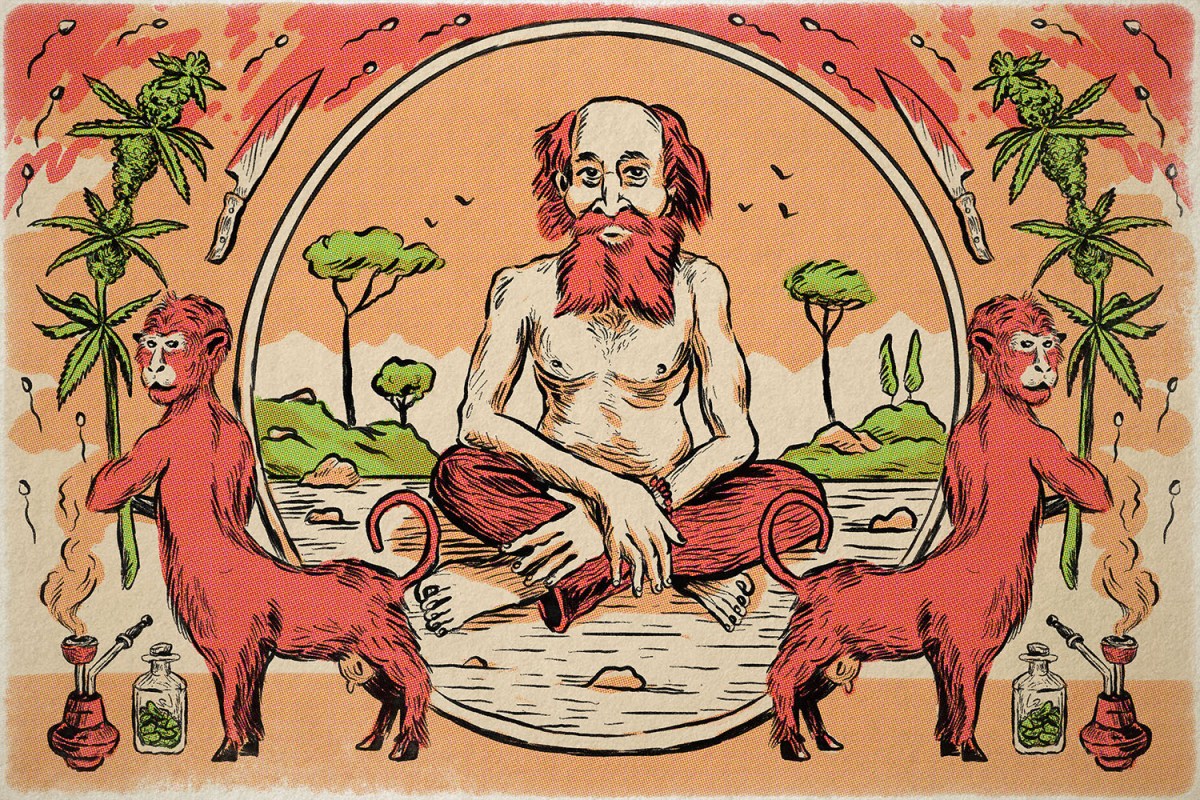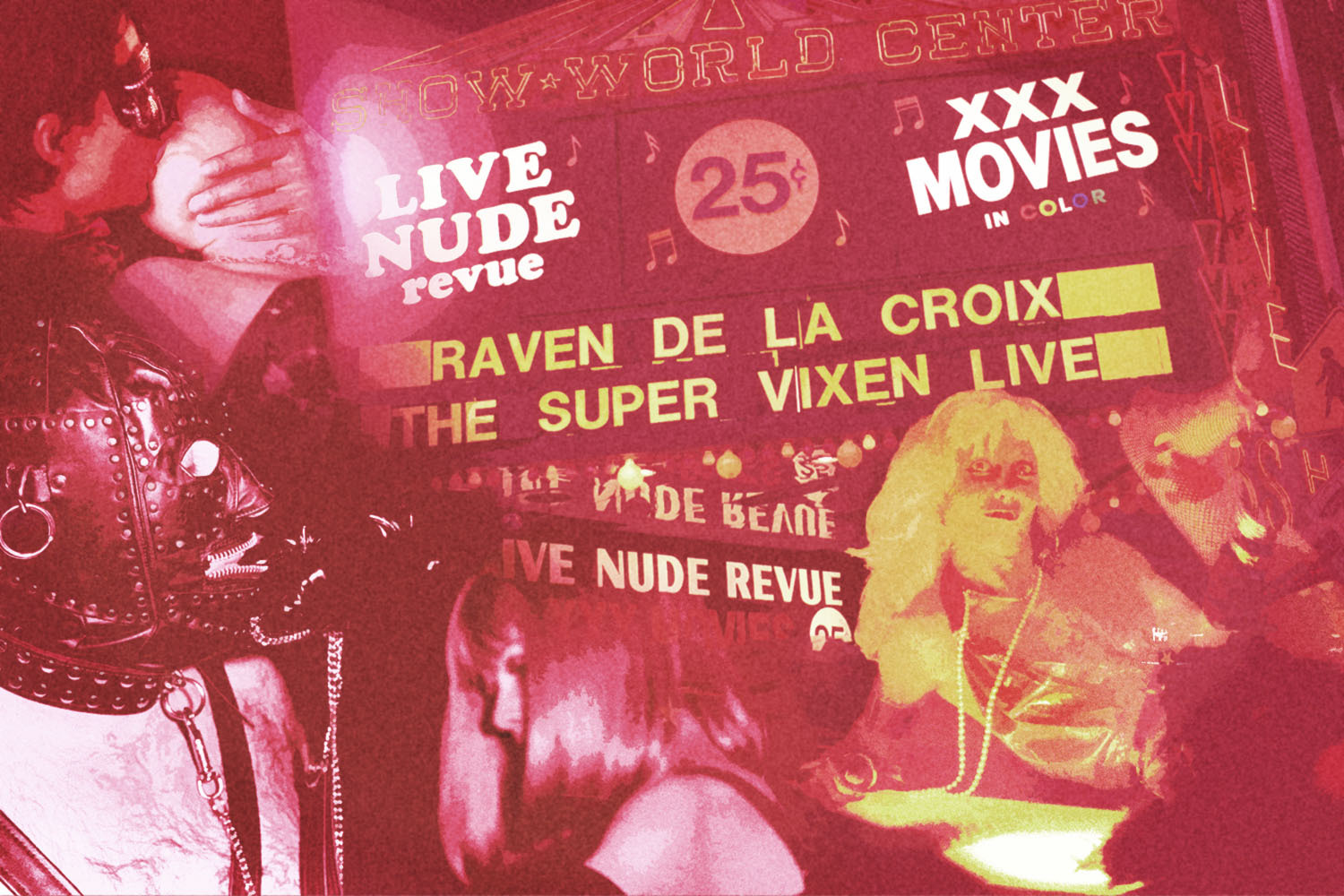In 1987, a team of excavators from around the world converged on a rock formation in Sipoo, a town on the eastern edge of the Helsinki metropolitan area. Below this solid stone, they believed they would find the tomb of Lemminkäinen, a Finnish folk hero and one of the central figures of the Kalevala, Finland’s national epic. This was not some fly-by-night treasure-hunting venture; it was a major operation, backed by the country’s largest construction firm, followed closely by the press, and monitored cursorily by the state. But it was initiated and progressed entirely on the advice, and under the guidance, of one man. Most Finns knew him by the pseudonym Ior Bock.
Bock was not an archaeologist, nor a trained expert in Finnish history. He spent most of his adult life as a charismatic yet questionable tour guide in Helsinki. But in 1984, he’d announced he was actually the last carrier of an ancient oral tradition that detailed the long-suppressed true history of the world, as well as a set of beliefs and rituals guaranteed to bring peace and wisdom to all. And those rituals focus heavily on absolutely outré sexual practices, like auto-fellatio and the consumption one’s own cum—or a close friend’s—in order to harness the life essence within it.
That so-called history, which conveniently placed the roots of all civilization in Finland (and the tomb of Lemminkäinen on Bock’s property), is so inane that even Ancient Origins, a site known for reporting conspiracy theories with utter credulity, argued it does not stand up to scrutiny.
Yet despite the wild and baseless nature of his claims and prescriptions, Bock somehow quickly garnered a small but notable core following — and a surprising degree of influence on Finnish subcultures. (Notably, the Finnish psychedelic rock group Kingston Wall, a cult hit, drew clear and direct inspiration from Bock’s works.) And he retained that following and influence after this excavation not only failed to yield any sign of ancient secrets and treasures, but collapsed into debt and scandal in 1990. After local journalist Magnus Londen debunked most of Bock’s claims about his personal lineage and history in an influential 2004 exposé. Even after one of the aging Bock’s caregivers stabbed him to death with a kitchen knife in his Helsinki apartment in 2010.
In fact, Bock and his strange, sexed-up history have arguably achieved greater visibility since his death thanks to the release of several (largely uncritical) indie docs about them, the compilation and translation of his tales, and their spread to new audiences across the globe via social media. Carl Borgen, a longtime observer of Bock and his flock, who published The Bock Saga, a 264-page English-language introduction to Bockian history and belief, has argued that the teachings have at least a million followers worldwide. Other experts on Bock and his influence believe that figure is certainly exaggerated — yet they too note that not just diehard old-timers but a growing stream of newcomers still descend on Sipoo every year, in search of the tomb Bock promised.
“His story is so powerful,” insists Michel Merle, who met Bock on the hippie travel circuit in 1975, followed his teachings from 1984 onwards and still works on updating, translating, and sharing Bock’s Saga. “Because of that, it is attracting more and more people, day by day.”
That, at least, is the insider interpretation of Bock’s success, in both life and death. But a more skeptical look at Bock’s life, and the development and spread of his Saga, tell a different tale — one that might shed light on the rise of other fringe belief systems and their ability to exert outsized influence on cultural life, political dialogue and even sexual mores across the globe.
The Beginning
According to official documents, Bock was born in 1942 to an unmarried 23-year-old woman and an unknown father, and adopted by the Helsinki businessman Bertel Svedlin and his wife, Rhea Boxstróm-Svedlin, who named him Bror Holger Svedlin. The couple sent Holger (Finns at the time often referred to each other by middle names, as it turns out) to a Swedish-language elementary school, where he struggled not only with his studies, but with whispers about his dark complexion — about how one of his real parents must have been a Cossack, a Roma, a Spaniard, or some other stigmatized outsider. Then, when Holger was 8, Bertel died unexpectedly and Rhea, for lack of support, had to send him to an orphanage for several years, a traumatic shift made all the harder because the orphanage operated solely in Finnish, which Holger had not learned well growing up. He reportedly suffered brutal discipline.
According to Londen’s reporting, friends and family say Holger responded to these hardships by turning to performance — wild dance and flamboyant antics that’d put him at the center of more positive attention. By age 15, he’d maneuvered his way into an apprenticeship as a lighting technician at Helsinki’s Swedish-language theater, through which he talked and cajoled his way into acting gigs, and started to rub shoulders with members of Finland’s growing counterculture. At some point around this time, he started to invent narratives about his true parentage—that his father was a Spanish sailor, for instance — and asked people to start calling him Brori instead of Holger. Which then morphed into Iori, a play on the Swedish pronunciation of Eeyore from Winnie the Pooh, whose melancholy resonated with Holger. Soon enough, he was Ior. And eventually he ditched Svedlin for a short version of his adoptive mother’s maiden name: Bock.
But in 1962, when Bock was 20, a tragic accident threw a wrench into his promising trajectory. As he reportedly later told local police, he and his older, also adopted brother Erik were hanging out in their parents’ house, listening to music, when Bock, dancing about wildly, picked up his grandfather’s 7.65 mm pistol and started swinging it around as a prop. On a flourish, he accidentally fired a shot into Erik’s chest, killing him. The authorities and Bock’s family accepted this story, and tried to move on with their lives. But Bock allegedly soon walked it back, calling Erik’s death a suicide, and went right back to glib showboating and nights out dancing — which some of his associates told Londen might have been a sublimation of grief, but which pissed off many of those around him. Soon after, Bock went abroad for a while. No one’s sure where or what he did.
In 1968, he reemerged as a tour guide at Suomenlinna, a fortress built across several islands off the coast of Helsinki by Sweden in 1748, as a bulwark against Russian expansion into the region. Bock apparently felt a great affinity for the site. He claimed his adoptive mother’s family had a personal connection to its construction and early history. But perhaps it just spoke to him, as someone eager to reconcile his Swedish-language upbringing with his desire to connect himself firmly to Finnish history and identity. Whatever the case, he became a uniquely popular guide, thanks to his flair for performance, and his vigor for stories of daily life in the forts during their earliest days. “Kids in that era, most of them took school trips to the fort, and their parents, as well as many other people,” recalls Merle. “Among them, he became very well known.”
His fame grew locally in the ’70s, as he featured in prominent TV ads — including this dance number promoting Coral detergent. He also became a fixture of the global hippie movement’s travel circuit, as in 1974 he started a tradition of traveling down to Goa to party and pursue new religious and philosophical thought every winter, returning to Helsinki in the spring and summer. While there, he’d participate in wild group sex, free love and all that groovy, erotic jazz.
Then, in the early ’80s, the fort’s managers grew increasingly skeptical of, even hostile towards Bock. No one today knows exactly why that was. He told Merle that authorities wanted him to tell a bogus, nationalist version of the fort’s history, but he refused to do so on principle. Fellow fort workers at the time told Londen that it’d become clear Bock was making up outlandish, detailed narratives about fort residents that no one else had ever heard of, claiming that Rhea’s family had recorded them all in secret oral histories, and that his transmission of them was the proof of their reality. Popular rumors claim that his shorts were just too short, and as such his genitals were constantly poking out of the bottom, causing discomfort or distress for others.
By mid-1984, Bock had lost his job at Suomenlinna (although he kept working as an unlicensed, freelance tour guide there until 1999), and Rhea had died. After returning from India that year, he started telling everyone who would listen that he was actually Rhea’s biological son — but that she had to hide that fact with a fake adoption story because he was the product of incest. His uncle, the only male scion of the family, died in the 1918 Finnish Civil War, leaving his aging grandfather no choice but to impregnate his daughter to produce the pure male Bockström heir destined to reveal the secrets their family had guarded since the time of the ancients. His grandfather died just before his birth, and Rhea tutored him in these ancient ways all his life, leaving him a will that instructed him to share them with the wider world for the first time ever.
Conveniently, none of his immediate family members could contradict this account of his origins or life at this point — though his extended family and early friends call it all pure bullshit.
The Saga
Bock relayed his family’s supposed Saga piecemeal, in oral transmissions recorded on tape by his followers, which makes it difficult for many — even his longtime associates — to assemble a cohesive narrative. But a short and broad version of his history of humanity runs as follows:
Millions of years ago, humanity emerged at the North Pole as the product of a hybrid union of goats and monkeys. These early humans developed an advanced, enlightened civilization — but only a pocket of this culture survived the ice age, hidden in the warmth of the Garden of Eden, conveniently located in Finland. Once the ice thawed, these enlightened individuals built ships to save the rest of humanity, and dispersed across the earth as prophets and guides to lead ravaged cultures back to civilization, in the process giving rise to every great culture, religion and language in the world.
It just so happened that this root language sounded a lot like the tongues Bock spoke — English, Finnish and Swedish. And this sex-and-fertility-focused faith mirrored the New Age, quasi-Indic beliefs and tantric sexual practices with which he and the hippie circles he ran in were experimenting.
Bock explained that knowledge of this universal, true history and faith only vanished because the imperial force of Christianity rooted it out as it spread across Europe. (No word on why it would have vanished in non-Christian areas.) His family, as one of the last descendants of the ancients and stalwart keepers of this lore, swore to protect the oral tradition from Christian influence until they determined the time was right to reveal it to a grateful world and usher in a new golden era.
“It’s an outrageous story,” Merle acknowledges. “It sounds totally ridiculous to anyone.”
Beyond outrageous, it wasn’t even consistent. It didn’t match up well with the Finnish myths and history that it was clearly riffing off of. And Bock reportedly responded to most requests for clarification or detail with evasive rhetoric, or long and winding tangents that redirected the asker toward some other tantalizing detail, or a pseudo-philosophical New Age-style platitude.
“Focusing on individual aspects of the story prevents people from looking at the reality behind the whole of it,” argues Merle. He says it can take up to 20 years to develop a full understanding of Bock’s tales. But if you take them on their own terms, then they all make clear and total sense.
He adds that Bock’s teachings about language also prove the validity of his beliefs. These are esoteric, but at their heart they claim that each syllable of a word in English conveys an ancient, unchanging core meaning that contains the history and power of the concept within it. For example, Merle explains, the word healthy clearly comes from the root language words heal and tea. Which sounds like healing someone using teas made of local herbs. Hence, the true origins of health lie in knowledge of how to make cures and foods using local herbs. Which is exactly what the Bock Saga explains the ancients did and we should do now. So clearly it’s true!
This is, of course, ridiculous on many levels.
Londen suggests that Bock’s story was likely just a showboat-fabulist’s clumsy and ill-informed effort to create a story that would not only bring him the attention he so craved, but help him to overcome the traumas of his childhood—his sense of dislocation and his uncertain identity.
Yet when he started sharing his so-called ancient wisdom in 1984, enough people listened with at least a degree of credulity that a couple of university students connected to Helsinki’s Archive of Folklore saw fit to come down to his family home and record a few of his stories. Over the next few years, public broadcasters and other researchers took an interest in his pure bullshit as well.
Why did so many people listen—and some of them take Bock seriously enough to become his disciples and structure their lives to varying degrees around his story—to such patent garbage?
As George Chryssides, an expert on new religious movements, once told me, “there is no one answer as to why people are attracted to a new belief system, cosmology or group.”
However, Michael Kropveld of Info-Secte, a Canadian organization that monitors, collects the materials created by, and develops analyses about new beliefs and the groups built around them, notes that prophets often flourish in communities that are questioning traditional structures. “They find something that attacks the structure they’re against and they say, ‘it must be okay,” he adds, especially if that new cosmology or ritual system is still rooted in familiar cultural tropes, and packaged in a dramatic, compelling narrative. It helps if there’s a little sex to sell it all, too.
“I’m not convinced that people who get involved in these kinds of groups bother much about the details of their philosophy,” Chryssides concurs.
Timo Lehtinen, one of Bock’s old followers who monitors his long inactive personal website, says that most of his early followers were part of the counterculture. Merle adds that he and many other early Bock acolytes were especially sick of traditional history, which they saw as a fabrication of modernity and nationalism intended to turn them into good little patriots—and of Christianity, which they believed did nothing but alienate people from human nature and sew division that ultimately led to violence, suffering and the suppression of all that’s truly good.
Merle adds that he and other early followers were also contemptuous of any sort of expertise. He believes that academics don’t exist to challenge orthodoxies and authorities or engage in truly diverse debates of ideas, but instead to suppress human intuition and natural knowledge—to reinforce modernity, nationalism and ultimately the conflict and industry that keep us all sick and embattled, under the thumb of the powers that be. He and many others like him believe that all truth should be intuitive enough that anyone can grasp it by feeling and personal observation.
“Only if you have the right qualifications do you have the right, in our modern world, to say anything,” Merle sneers. “Otherwise you are a nutcake… The experts want to make us normal.”
“When Ior told me his story, I could catch onto it much more quickly than I could catch onto science,” he says. “It made much more sense to me than any history book ever did.” He waves away criticisms of the consistency, historicity, or any other element of Bock’s stories as little more than experts failing to acknowledge or engage with intuitive truth out of pure smugness.
Lehtinen adds that Bock’s narrative didn’t just play into counterculture sensibilities of the era. “It is also the only significant symbolic system that connects Finnish and Scandinavian mythology,” he says, offering many people in Finland specifically a story they longed for. It probably didn’t hurt that Bock’s story played into national pride while simultaneously rejecting nationalism.
Bock’s success — and the success of any wild new belief, really — thus boils down to a simple formula: Right story. Right audience. Right time.
Bock’s early wave of success came to an end in 1990. Although he and his followers insisted the excavation on his family’s land in Sipoo was right on the edge of a major breakthrough, official observers decided that there was nothing in those stones—and the team was burning through money. Although Lehtinen insists Bock never ran the project, Londen’s reporting shows that he did put up most of his assets as collateral for a loan from a local bank—and then took another loan out from the construction company backing the venture—in order to fund the work. So, he was already deeply in debt with no sign of a payout. Then, the police raided his Sipoo outpost.
As hardcore hippies, Bock and his followers smoked a ton of weed; he said this was an ancient family tradition as well. However, weed was illegal in Finland at the time. The police argued that his international collaborators were actually using their visits to the site to smuggle in foreign hashish, which they then sold to others, making them the lynchpin of a major drug trafficking ring. However, Merle insists that the cops only busted them because they were getting too close to a big discovery that could upend expert understandings of history. Whatever the case may be, the bust scooped up a couple dozen Bockians, deported the internationals and ended in notable fines, which all but shut down the main excavation—and threw Bock officially into ill repute.
As his popularity waned, Bock made less and less money from his unofficial tours in Helsinki, until by the late ‘90s he was just barely scraping by, largely on government assistance and aid from his closest friends and companions. No one’s sure why, but in 1999 one of the members of the inner circle supporting him stabbed Bock in the back four times, propelling him back into the national spotlight for a moment, but leaving him partially paralyzed. The next year, officials came calling for his debts, repossessed all of his family’s old property, and put it up for auction.
For the next 10 years, Bock spent most of his time sitting cross-legged in his apartment, sharing his stories with whoever might come but too poor and weak for the performance and travel that used to fuel him. In a 2003 interview, he told Londen of his penis, “The fish still stands pretty well, but I have a hard time getting it to fire,” limiting his ability to consume his own wisdom.
Then one day in 2010, one of his two young live-in caregivers, both of whom regularly smoked weed with him, got far too high and had a psychotic episode. He saw dark birds around Bock’s apartment, and heard voices. He became convinced this was all a manifestation of Bock—the Devil’s—dark magic, and that he had to eliminate this evil from the world. He stabbed Bock nine times, killing him. A court found the man innocent of murder, given the circumstances of the manslaughter, after a long trial, but they ultimately deported him back to India over a year later.
“This makes it sound like our Saga is so crazy that it makes people go insane in the head and stab the person telling it,” Merle complains about the coverage of the murder at the time.
The Legacy
You might expect that to be the end of Bock and his Saga. He was a strange man. He told a strange story. It spoke to a specific group of people, in a specific cultural moment. But the moment passed. The man died. His revelation became a colorful footnote in a true crime story.
But that wasn’t the end.
Even at his lowest point, Bock’s core followers continued recording his stories—and digging at Sipoo. (A few of them managed to snap up a section of the rock formation at auction.) As they kept Bock’s legacy alive, they slowly attracted attention from a new generation of wanderers.
Alexander Popov, a Russian indie director, tells me that he met one of Bock’s core followers in India, learned about their views and their work at Sipoo, and found it all oddly compelling. Not the Saga itself, necessarily; he seems agnostic on Bock’s history, and even its most eye-popping sexual rituals and esoteric beliefs. But the legend of the man—his effect on the community that surrounded him—seemed like a good story in and of itself. So, he made a film about them. Several other filmmakers, writers and influencers have done the same since 2015.
Through their works, far more people than ever before have encountered Bock and his history and beliefs. Some have embraced them wholeheartedly, traveling to Sipoo, learning his root language system, and perhaps even ingesting the sacred sexual wisdom as he prescribes. But many have pulled piecemeal, for little bits of perceived insight or inspiration. Which Merle says is fine, since “we have never centralized anything” about the Saga, never dictated interpretation.
Wild beliefs like Bock’s rise and thrive, exerting a surprising amount of influence on the world around them, by speaking to a particular audience at a particular moment. But they survive in remixes of a compelling story, adapted, tweaked or edited for a new era’s needs and anxieties.
Lehtinen believes that Bock’s “legacy is still largely un-understood.” To be determined only far in the future, when we’ve seen the full cultural and historical repercussions of his wild ideas.
About this, at least, he’s almost certainly right.
This article appeared in an InsideHook newsletter. Sign up for free to get more on travel, wellness, style, drinking, and culture.






















